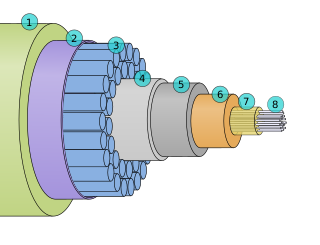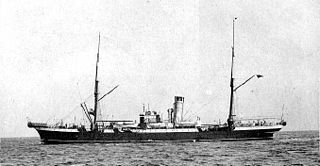
A submarine communications cable is a cable laid on the seabed between land-based stations to carry telecommunication signals across stretches of ocean and sea. The first submarine communications cables were laid beginning in the 1850s and carried telegraphy traffic, establishing the first instant telecommunications links between continents, such as the first transatlantic telegraph cable which became operational on 16 August 1858.

Transatlantic telegraph cables were undersea cables running under the Atlantic Ocean for telegraph communications. Telegraphy is an obsolete form of communication, and the cables have long since been decommissioned, but telephone and data are still carried on other transatlantic telecommunications cables.

Commercial Pacific Cable Company was founded in 1901, and ceased operations in October 1951. It provided the first direct telegraph route from America to the Philippines, China, and Japan.
Charles Mitchell was a Scottish engineer from Aberdeen who founded major shipbuilding yards on the Tyne. He became a public benefactor who funded notable buildings that still survive today.

The Electric Telegraph Company (ETC) was a British telegraph company founded in 1846 by William Fothergill Cooke and John Ricardo. It was the world's first public telegraph company. The equipment used was the Cooke and Wheatstone telegraph, an electrical telegraph developed a few years earlier in collaboration with Charles Wheatstone. The system had been taken up by several railway companies for signalling purposes, but in forming the company Cooke intended to open up the technology to the public at large.

A cable layer or cable ship is a deep-sea vessel designed and used to lay underwater cables for telecommunications, for electric power transmission, military, or other purposes. Cable ships are distinguished by large cable sheaves for guiding cable over bow or stern or both. Bow sheaves, some very large, were characteristic of all cable ships in the past, but newer ships are tending toward having stern sheaves only, as seen in the photo of CS Cable Innovator at the Port of Astoria on this page. The names of cable ships are often preceded by "C.S." as in CS Long Lines.

The Atlantic Telegraph Company was a company formed on 6 November 1856 to undertake and exploit a commercial telegraph cable across the Atlantic Ocean, the first such telecommunications link.

The Cable Ship Mackay-Bennett was a transatlantic cable-laying and cable-repair ship registered at Lloyd's of London as a Glasgow vessel but owned by the American Commercial Cable Company. It is notable for being the ship that recovered the majority of the bodies after the sinking of the Titanic.
William Thomas Henley (1814–1882) was a pioneer in the manufacture of telegraph cables. He was working as a porter in Cheapside in 1830, leaving after disputes with his employer, and working at the St Katherine Docks for six years. During those years he was determined to learn a trade and used money from an aunt to purchase a lathe, vice and lumber with which he made a work bench. With those tools he taught himself to turn wood and brass and began to experiment, including with electricity.
William Hooper was a British chemist.
CS Telconia was a British cable ship used in the early 20th century to lay and repair submarine communications cables. She was built in 1909 by Swan Hunter & Wigham Richardson for the Telegraph Construction and Maintenance Company and remained in service until late 1934.
USS Nashawena (AG-142/YAG-35) was a U.S. Navy cable layer constructed during World War II for the Army as the wooden-hulled self-propelled barge BSP 2008. The barge was completed converted to cable work for U.S. Army Signal Corps as the cable ship Col. William. A. Glassford supporting the Alaska Communications System in the shallow island waters of Alaska. She was transferred to the U.S. Navy in 1947 as a miscellaneous auxiliary and assigned to cable-laying duties for the U.S. Pacific Fleet.

Sir Samuel Canning (1823–1908) was an English pioneer of submarine telegraphy.
CS Pacific was a cable ship registered in Copenhagen, Denmark owned by the Great Northern Telegraph Company. The steel vessel was built in 1903 in the shipyards of Burmeister & Wain and delivered that year for the purpose of laying and repairing submarine cable in the Far East networks. Historical records of this cable ship are kept in the National Maritime Museum of Denmark. Pictorial records of the ship are available through the DieselHouse interactive initiative.

The India Rubber, Gutta Percha and Telegraph Works Company was a London-based company based in Silvertown, East London. It was founded by Stephen William Silver in March 1864 as Silver's Indiarubber Works and Telegraph Cable Company Ltd. However in July that year the name was changed to the India Rubber, Gutta Percha and Telegraph Works Company.
The Submarine Telegraph Company was a British company which laid and operated submarine telegraph cables.

The Gutta Percha Company was an English company formed in 1845 to make a variety of products from the recently introduced natural rubber gutta-percha. Unlike other natural rubbers, this material was thermoplastic allowing it to be easily moulded. Nothing else like it was available to manufacturing until well into the twentieth century when synthetic plastics were developed.

The British and Irish Magnetic Telegraph Company was founded by John Brett in 1850. The Magnetic was the principal competitor to the largest telegraph company in the United Kingdom, the Electric Telegraph Company. The Magnetic was the leading company in Ireland, while the Electric was the leading company in mainland Britain. Between them, they dominated the market until the telegraph was nationalised in 1870.
HMTS Monarch, launched on 8 August 1945 and completed during February 1946, was the fourth cable ship with that name. The ship was built for the General Post Office (GPO) for the laying and repair of submarine communications cable and was the largest cable ship in the world when completed and the first cable ship to have all electric cable machinery.

In the nineteenth century, the United Kingdom of Great Britain and Ireland had the world's first commercial telegraph company. British telegraphy dominated international telecommunications well into the twentieth. Telegraphy is the sending of textual messages by human operators using symbolic codes. Electrical telegraphy used conducting wires to send messages, often incorporating a telegram service to deliver the telegraphed communication from the telegraph office. This is distinct from optical telegraphy that preceded it and the radiotelegraphy that followed. Though Francis Ronalds first demonstrated a working telegraph over a substantial distance in 1816, he was unable to put it into practical use. Starting in 1836, William Fothergill Cooke, with the scientific assistance of Charles Wheatstone, developed the Cooke and Wheatstone telegraph. The needle telegraph instrument suggested by Wheatstone, the battery invented by John Frederic Daniell, and the relay invented by Edward Davy were important components of this system.












